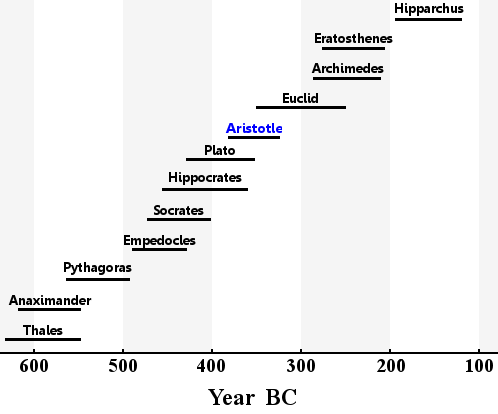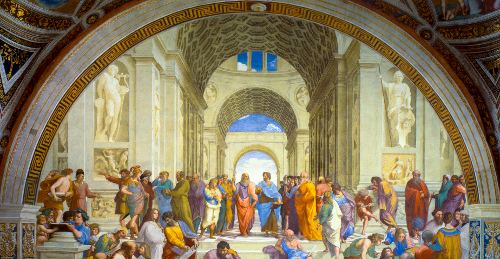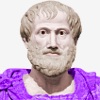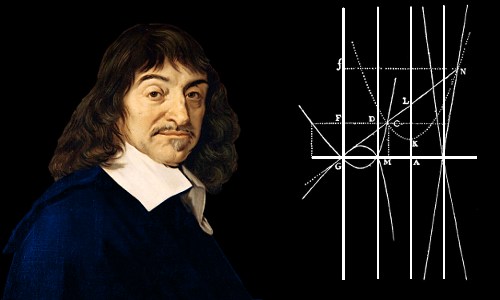Aristotle

Lived 384 – 322 BC.
Aristotle’s influence on western culture and science has been enormous. His writings, many of which survived great periods of turmoil in the millennia separating us from him, show him to be a man of tremendous intellect who thought deeply about the world.
The volume, extent and depth of his work is humbling.
Speaking from our privileged place in time, it is evident that much of his work actually weakened the progress of science. There are, however, exceptions to this: for example, some of his works on biology and geology. He also founded the study of formal logic.
Aristotle’s philosophy is still studied today, but his science is not.
Beginnings
Aristotle was born in Ancient Greece in 384 BC, very nearly 2400 years ago. He was born in the city of Stagira in the Greek state of Macedonia.
His early life was very comfortable. His father, Nicomachus, was a physician. His mother, Phaestis, came from a wealthy family: they owned a sizable estate near the town of Chalcis on Euboea, the second-largest of the Greek Islands.
When Aristotle was a young boy, his father was appointed by King Amyntas III of Macedonia to be his personal physician.
Both of Aristotle’s parents died when he was young, his father dying when he was 10. Aristotle was then brought up and educated by Proxenus of Atarneus, who was probably his uncle and also a physician.
Proxenus treated Aristotle like a son, ensuring he had the best education possible. Given this was Ancient Greece, this education was very good indeed.
Two hundred years had passed since the earliest Greek scientists such as Thales and Pythagoras had first set Ancient Greece on the path to becoming an intellectual superpower. In Aristotle’s time, wealthy Greeks expected their children to be highly accomplished academically.
Lifetimes of Selected Ancient Greek Scientists and Philosophers

Athens and Plato
In the year of Aristotle’s birth, the great philosopher Plato had founded a famous academy in Athens. Tuition was free of charge, but only people chosen by Plato could enroll at the school.
Like Pythagoras’s earlier school, Plato’s Academy welcomed both sexes.
At the age of 17, Aristotle traveled to the magnificent city of Athens and joined Plato’s Academy. There he was schooled in many fields, including science, philosophy, and mathematics.

The School of Athens, a fresco completed by the Italian artist Raphael in 1511. The central figures are Plato, in red on the left, and Aristotle, in blue on the right.
Aristotle stayed with Plato’s Academy for approximately 20 years, becoming in time a teacher. He then decided it was time to pursue a solo career.
Teacher of Alexander the Great
Aristotle spent some time traveling within the borders of the Greek Empire studying the natural world.
He met and married Pythias with whom he fathered a daughter, also named Pythias.
In 343 BC he returned to his home state of Macedonia. There, at the age of 41, he became director of the Royal Academy of Macedonia and tutor to Alexander, son of King Philip II of Macedonia.
Alexander was destined to conquer a large part of the world and be known as Alexander the Great. Aristotle tutored him from age 13 to 16, giving the boy strong foundations in philosophy, medicine, morals, and the arts. At the age of 16, Alexander became Macedonia’s ruler in his father’s absence.
Before agreeing to tutor Alexander, Aristotle had successfully demanded of Philip II that he:
- rebuild Aristotle’s home city of Stagira, which he had destroyed,
- allow Stagira’s exiled citizens to return, and
- free any of Stagira’s ex-citizens who had been enslaved
Balanced against this altruism, Aristotle disliked the ‘barbarians’ who lived to the east of Ancient Greece. He urged the young Alexander to conquer these lands and treat the people as animals. (This was a common point of view in Ancient Greece, whose people had twice in the previous century fought off attempts by the armies of Persian kings to subjugate them.)
Alexander went on to conquer lands as far east as India, but he treated conquered peoples more sympathetically than Aristotle urged. If possible, he made alliances with once hostile cities rather than destroying them, and he asked his generals and soldiers to marry women in conquered lands.
Aristotle’s Science
Aristotle wanted a piece of all available intellectual action.
He published a large number of works in fields as diverse as poetry and politics; religion and rhetoric; logic and literary theory; music and metaphysics; and many other fields, centered chiefly around philosophy.
He also published a substantial body of scientific work, which we’ll now look at briefly.
Chemistry and Alchemy
The Ancient Elements
Modern chemistry is based on the periodic table’s elements and their compounds.
Modern chemistry is based on the periodic table’s elements and their compounds.
Aristotle’s ‘chemistry’ was based on the system developed by Empedocles (c. 490 BC – c. 430 BC).
Empedocles said there were four fundamental elements, and these elements combined to produce all the substances around us. The four elements were: air, earth, fire and water.
We need to appreciate these four elements were not elements in the way we now understand the word. Empedocles and Aristotle believed all matter was the same, but it behaved differently according to the qualities present. For example, the metals lead and gold were made of the same matter, but contained different amounts of the ‘qualities’ of air, earth, fire and water. Therefore, by adjusting the amount of air, earth, fire and water, you could change one substance into another.
Aristotle’s Perfect First Element
Aristotle, after much thought, added another element. He called this the first element; it later came to be called the aether or the quintessence. This element did not exist on Earth, it only existed in the heavens.
Aristotle, after much thought, added another element. He called this the first element; it later came to be called the aether or the quintessence. This element did not exist on Earth, it only existed in the heavens.
Aristotle believed that the four earthly elements moved in straight lines, but the ‘first element’ followed a perfect path, a circle, explaining why heavenly bodies followed circular paths around Earth. The perfect ‘first element’ did not combine with other elements, it remained forever pure. The sun, moon, planets, and stars were perfect because they contained this element.
Aristotle’s Elements
Quintessence
Fire
Air
Water
Earth
Aristotle’s Influence on Alchemy
The science of alchemy was built around the five Ancient Greek elements.
The science of alchemy was built around the five Ancient Greek elements.
Alchemists believed a small amount of Aristotle’s quintessence had drifted down to Earth and if they could harness its properties they could cure diseases with it. Some came to identify it with the Philosopher’s Stone, which could be used to turn other metals into gold and grant eternal life to anyone who consumed it.
Modern chemistry owes a debt to the practical methods developed by alchemists. However their theories, based on the ideas of Empedocles and Aristotle, hindered the development of chemistry for over 2000 years.
Biology
In contrast to his highly theoretical approach to chemistry, Aristotle the biologist was perfectly happy to get his hands dirty dissecting animals. His father and uncle were physicians, which may have influenced Aristotle’s approach. His biological observations were more accurate than his chemical ones.
He was the first naturalist whose books may still be read today.
 “By ‘life,’ we mean a thing that can nourish itself and grow and decay.”
“By ‘life,’ we mean a thing that can nourish itself and grow and decay.”
ARISTOTLE, 384 BC TO 322 BC
Scientist, Philosopher
Aristotle produced his own classification of life, placing animals in groups according to features the animals had in common. He called each of these groups a genus and identified 11 of these.
Aristotle went out to sea with fishermen. He observed wildlife and examined fishermen’s catches.
He was the first scientist to write that dolphins are not fish – he observed that they have lungs, they give birth to live offspring, which are fed milk by their mothers. He grouped dolphins with porpoises and whales in a genus he called Cetacea.
 “…for they are provided with lungs. The dolphin has been seen asleep with its nose above water as he snores.”
“…for they are provided with lungs. The dolphin has been seen asleep with its nose above water as he snores.”
ARISTOTLE, 384 BC TO 322 BC
Scientist, Philosopher
In the end, Aristotle identified close to 600 species of life.
He was the first scientist to place species into different groups based on their shared features, a method later adopted by biologists such as Carolus Linnaeus. This method was used until DNA comparison displaced it.

Aristotle identified that dolphins are not fish, because they have lungs and feed their young milk.
Although much of his best science was biological, Aristotle made inexplicable mistakes in this field, such as the following one commented on by Andreas Vesalius in his work De Humani Corporis Fabrica in 1543:
 “Aristotle and many others say men have more teeth than women; it is no harder for anyone to test this than it is for me to say it is false, since no one is prevented from counting teeth.”
“Aristotle and many others say men have more teeth than women; it is no harder for anyone to test this than it is for me to say it is false, since no one is prevented from counting teeth.”
ANDREAS VESALIUS, 1514 TO 1564
Anatomist
Unlike modern mainstream biologists, Aristotle believed that lifeforms were designed with a purpose.
He also believed some organisms were generated spontaneously, an error that again persisted until relatively recently. Evidence from scientists such as Antonie van Leeuwenhoek, Theodor Schwann, and Louis Pasteur eventually established that Aristotle was wrong.
 “For some plants are generated from the seed of plants, whilst other plants are self-generated through the formation of some elemental principle similar to a seed… So with animals, some spring from parent animals according to their kind, whilst others grow spontaneously and not from kindred stock; and of these instances of spontaneous generation some come from putrefying earth or vegetable matter, as is the case with a number of insects, while others are spontaneously generated in the inside of animals out of the secretions of their several organs.”
“For some plants are generated from the seed of plants, whilst other plants are self-generated through the formation of some elemental principle similar to a seed… So with animals, some spring from parent animals according to their kind, whilst others grow spontaneously and not from kindred stock; and of these instances of spontaneous generation some come from putrefying earth or vegetable matter, as is the case with a number of insects, while others are spontaneously generated in the inside of animals out of the secretions of their several organs.”
ARISTOTLE, 384 BC TO 322 BC
Scientist, Philosopher
Geology
The great geologist Charles Lyell noted Aristotle’s astute observations about our planet’s surface. Aristotle recognized that the earth’s surface features are not permanent: lakes dry up, deserts become wet, and islands may form as the result of volcanic eruptions. Areas that were once sea may become land, and vice versa.
Aristotle wrote that most changes on the earth’s surface are not grasped by people, because they happen on timescales very much longer than a human life.
 “…rivers; they spring up and they perish; and the sea also continually abandons some lands and invades others. Areas of the earth are not always sea, and others always continents, but everything changes in the course of time.”
“…rivers; they spring up and they perish; and the sea also continually abandons some lands and invades others. Areas of the earth are not always sea, and others always continents, but everything changes in the course of time.”
ARISTOTLE, 384 BC TO 322 BC
Scientist, Philosopher
Astronomy and Physics
Aristotle tried to understand the universe by just thinking about it rather than performing experiments or making measurements. This undermined his chances of formulating successful theories.
In saying this, it’s important to remember the importance of pure thought: Albert Einstein’s thought experiments, for example, resulted in a revolution in our understanding of physics.
The difference between Einstein and Aristotle, however, is that Einstein used calculations with numbers from other people’s experiments in formulating his new physics.
Aristotle’s physics was as much philosophy as science and this was probably its greatest weakness.
If Aristotle had become an experimental physicist, he would have had more or less the same experimental tools available as Galileo did 2000 years later; and quite possibly humans would have reached the stars by now.
Reading Aristotle’s physics, one senses a powerful mind at work, trying to make sense of the universe.
 “Time …First, does it belong to the class of things that exist or to that of things that do not exist? Then secondly, what is its nature? …One part of it has been and is not, while the other is going to be and is not yet. Yet time – both infinite time and any time you like to take – is made up of these. One would naturally suppose that what is made up of things which do not exist could have no share in reality…”
“Time …First, does it belong to the class of things that exist or to that of things that do not exist? Then secondly, what is its nature? …One part of it has been and is not, while the other is going to be and is not yet. Yet time – both infinite time and any time you like to take – is made up of these. One would naturally suppose that what is made up of things which do not exist could have no share in reality…”
ARISTOTLE, 384 BC TO 322 BC
Physics
Aristotle’s physics persisted for many centuries. In the end, it became intertwined with the teachings of the Catholic Church, so that to question the soundness of Aristotle’s physics or astronomy was regarded as questioning the Church’s authority.
Here are corrections to a sampling of Aristotle’s more unfortunate mistakes, mistakes that for all too many years steered science down any number of blind alleys:
- Copernicus and Kepler established that the earth orbits the sun – Aristotle was wrong when he said the sun orbits the earth.
- Galileo discovered satellites orbiting Jupiter, proving that everything in the heavens does not orbit the earth – Aristotle was wrong when he said everything in the heavens orbits the earth.
- Galileo’s telescope clearly showed mountains and craters on the moon, proving that the moon is far from perfect – Aristotle was wrong when he said the heavens are perfect.
- Galileo’s experiments proved that the rate at which something falls to earth does not depend on its mass – Aristotle was wrong when he said heavier objects fall to the earth faster than lighter ones.
- Galileo discovered that things keep moving in a straight line at uniform speed unless a force causes them to do otherwise. Aristotle was wrong when he said things only keep moving if you keep applying a force to them.
Aristotle’s Elements (Again)
Aristotle’s physics had no concept of gravity. Instead, substances found their ‘natural level’ depending on the proportions of the five elements present. For example, anything with a significant amount of water’s ‘quality’ in it would fall through quintessence, fire and air to reach its natural level, which would be above anything containing significant amounts of earth.
Aristotle’s physics had no concept of gravity. Instead, substances found their ‘natural level’ depending on the proportions of the five elements present. For example, anything with a significant amount of water’s ‘quality’ in it would fall through quintessence, fire and air to reach its natural level, which would be above anything containing significant amounts of earth.
Quintessence
Fire
Air
Water
Earth
Some of Aristotle’s mistakes were corrected, but the corrections were ignored.
For example, about 100 years after Aristotle claimed everything in the universe orbited the earth, Aristarchus reasoned correctly that the earth and the planets orbit the sun. Aristarchus also said correctly that the earth spins about its axis, where Aristotle had insisted that the earth is motionless.
Aristotle’s view won this battle of ideas for almost two millennia, until Nicolaus Copernicus began the scientific revolution in 1543.
Galileo finally made decisive breakthroughs in the early 1600s, combining the power of his mind with the power of experimentation. Galileo’s experiments asked sufficiently perceptive questions of Nature that the answers allowed him to begin building the physics we know today.
Ignore Numbers at your Peril
Aristotle certainly could have achieved better results by heeding the Pythagoreans, whose outlook he mentions in his work Metaphysica.
 “The Pythagoreans, who were the first to take up mathematics, not only advanced this field, but saturated with it, they fancied that the principles of mathematics were the principles of all things.”
“The Pythagoreans, who were the first to take up mathematics, not only advanced this field, but saturated with it, they fancied that the principles of mathematics were the principles of all things.”
ARISTOTLE, 384 – 322 BC
Metaphysica
Aristotle’s Logic
Aristotle founded the study of formal logic, systematizing logical arguments – he is famous for the syllogism, a method by which known information can be used to prove a point.
In a syllogism two premises that are believed to be true – one major, another minor – are used to produce a conclusion. Argument by syllogism dominated Western philosophy both in medieval times and later.
Here is a famous example, from Aristotle himself, of a simple syllogism:
- All men are mortal.
- Socrates is a man.
- Therefore, Socrates is mortal.
Aristotle was fully aware that if the premises were false, the conclusion would also be false. Here’s a famous false syllogism concocted by American journalist and Civil War Veteran Ambrose Bierce for his book The Devil’s Dictionary:
- Major Premise: Sixty men can do a piece of work sixty times as quickly as one man.
- Minor Premise: One man can dig a posthole in sixty seconds; therefore-
- Conclusion: Sixty men can dig a posthole in one second.
The relentlessly satirical Bierce wrote:
This may be called the syllogism arithmetical, in which, by combining logic and mathematics, we obtain a double certainty and are twice blessed.
In fact, combining logic and mathematics was precisely what Euclid did to produce the Elements, the greatest mathematical work in history. Euclid, who is believed to have been born in Aristotle’s lifetime, derived proofs in two-dimensional geometry, the conclusions of which are as correct today as they were when they were first written. Euclid wrote statements he believed to be true (such as that all right angles equal one another) and from these statements derived a large number of new and unexpected results. Scholars have different views about whether Aristotle’s work influenced Euclid’s.
Some Personal Details and The End
In fairness to Aristotle, we need to remember that his explanations of the physical world were generally trusted for almost 2000 years. Many more recent ideas may not resist modification for as long.
About ten years after he married Pythias, she died. Aristotle later fathered a son with Herpyllis, a woman from his hometown. The details of when this happened are sketchy. Aristotle’s son was named Nicomachus, in honor of Aristotle’s father.
In 335 BC, aged 49, Aristotle returned to Athens and established his own school, the Peripatetic School. He did not promote any specific views or doctrines: the spirit of the school was one of questioning and scrutinizing different philosophical and scientific theories.
Perhaps his own age was foremost in his mind when he when he founded his new school:
 “The body is most fully developed from thirty to thirty-five years of age, the mind at about forty-nine.”
“The body is most fully developed from thirty to thirty-five years of age, the mind at about forty-nine.”
ARISTOTLE, 384 – 322 BC
Rhetoric
The school ran successfully until Greece was shaken by terrible news: Alexander the Great was dead.
Aged just 32, Alexander had died in the year 323 BC in Babylon, far from his Macedonian homeland.
Alexander’s Macedonian army had united Ancient Greece, but not without spilling a lot of blood. With the death of Alexander, anti-Macedonian sentiment flourished in Athens. The result of this was that in 322 BC Aristotle, who was Macedonian, fled to the safety of his mother’s estate in Chalcis.
Aristotle died in Chalcis of natural causes, aged 62, soon after arriving. He was buried there next to Pythias, his first wife.

No comments:
Post a Comment